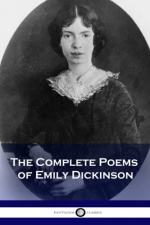|
This section contains 324 words (approx. 1 page at 400 words per page) |

|
I Heard a Fly Buzz When I Died (Poem) Summary & Study Guide Description
I Heard a Fly Buzz When I Died (Poem) Summary & Study Guide includes comprehensive information and analysis to help you understand the book. This study guide contains the following sections:
This detailed literature summary also contains Quotes and a Free Quiz on I Heard a Fly Buzz When I Died (Poem) by Emily Dickinson.
The version of this poem used to create this study guide appears in: Dickinson, Emily, and Thomas Herbert Johnson. The Complete Poems of Emily Dickinson. Little, Brown and Company, 2015.
Note that parenthetical citations within the guide refer to the lines of the poem from which the quotations are taken.
“I heard a Fly buzz – when I died” is a 16-line poem, made up of four quatrains, written by American poet Emily Dickinson. Like many of Dickinson’s other poems, it is written alternately in iambic trimeter and iambic tetrameter. It was posthumously published for the first time in 1896, close to a decade after Dickinson’s death. The poem was originally untitled and has since been referred to by its opening line.
Dickinson is well-known for defying literary conventions. By doing so, she created her own unique style which reflects the elements and ideals of the literary periods she lived through. Two of her most common writing quirks are the capitalization of words that are not usually capitalized, and repeated use of dashes. Both of these peculiarities are observable in the poem, and they inform and affect possible interpretations. The poem is a first-person narrative that examines the notions of death and the possibility of an afterlife from the perspective of a dead person. In the poem, the unnamed speaker recalls her final moments of life. She is lying on her deathbed, surrounded by people who have been crying. There is a tense atmosphere in the room as the mourners surrounding the deathbed wait for the speaker to pass on. The speaker leaves behind a will, in which she divides her earthly belongings amongst her survivors. A fly interrupts the scene and buzzes around the room. It hovers in front of the window, blocking the light. From the speaker’s perspective, the light begins to fade as the fly blocks it, and then it disappears completely, signaling the speaker’s death.
Read more from the Study Guide
|
This section contains 324 words (approx. 1 page at 400 words per page) |

|



